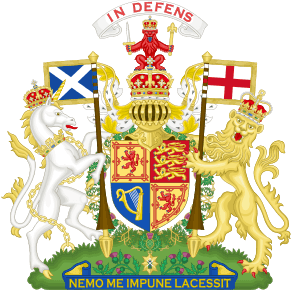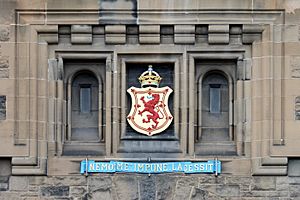Nemo me impune lacessit facts for kids

Nemo me impune lacessit is a famous Latin saying that means "No one can harm me without being punished" or "No one assaults me with impunity". It is the official motto of Scotland and has been used by the Scottish Royal family, the House of Stuart, for a very long time.
This motto first appeared on Scottish coins in the late 1500s, during the time of King James VI. Today, it is also the motto for the Order of the Thistle, which is a special group of knights in Scotland. You can also find it on the badges of several Scottish army groups in the British Army. In Scotland, this motto is sometimes said in Scots as "Wha daur meddle wi' me?" which means "Who dares to bother me?"
Contents
The Thistle: Scotland's Spiky Protector

The story behind this motto is quite interesting and involves Scotland's national flower, the thistle. Legend says that long ago, before the Battle of Largs in 1263, Viking invaders were trying to sneak up on the Scottish army at night.
The Vikings were barefoot, and one of them stepped on a sharp, prickly thistle. He yelled out in pain, which woke up the Scottish soldiers. This loud yell saved the Scots from a surprise attack! Because of this, the thistle became a symbol of protection for Scotland.
So, when the motto says "No one can harm me without being punished," the "me" originally referred to the brave thistle. Over time, it came to mean Scotland itself, and then the Scottish army groups that use the motto.
Other places have used similar sayings. For example, the city of Nancy in France has a motto that also talks about not being touched without revenge, and it also refers to the thistle.
Where You Can See the Motto Today

The motto Nemo me impune lacessit is very important in Scotland. It is the motto of the Order of the Thistle, which is a very old and respected group of knights.
It is also used by several famous Scottish army regiments, including:
You can also see this motto on the Royal coat of arms of the United Kingdom when it is used in Scotland. It appears around the shield, often with a collar from the Order of the Thistle. A very visible place to spot the motto is above the main entrance to Edinburgh Castle, a famous Scottish landmark.
Motto Use Around the World

This powerful motto isn't just used in Scotland! Other military groups and organizations around the world have adopted it too.
- In Australia, some army units, like the 3rd Battalion (PARA) Royal Australian Regiment, use this motto.
- The Black Watch (Royal Highland Regiment) of Canada, an infantry regiment in the Canadian Forces, also has this motto on its cap badge.
- The Cape Town Highlanders Regiment, an army unit in South Africa, uses it as well.
The motto has even appeared on Scottish coins, like the "Bawbee" (a sixpence coin) from the 1600s. It also appears on the rim of some British one pound coins that have Scottish designs.
Motto in Pop Culture
You might have heard this motto in books or stories!
- In Edgar Allan Poe's short story "The Cask of Amontillado", the motto is on a family's coat of arms.
- It's mentioned in the science fiction novel Fiasco by Stanisław Lem.
- In the novel Mortal Causes by Ian Rankin, the motto helps solve a mystery.
- In the game Warhammer 40,000, a group called the Raven Guard uses this motto.
The motto also appears on the crest of the Grand National Curling Club and on the back collar of the official kit for the Edinburgh Rugby team.
|


